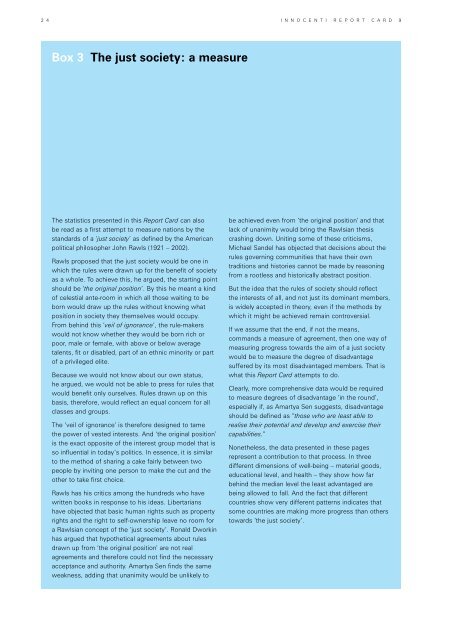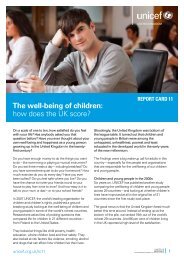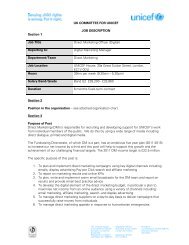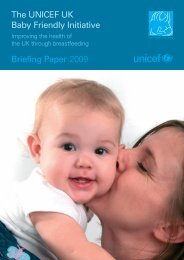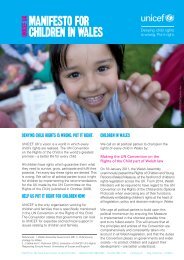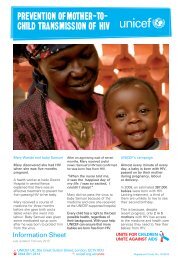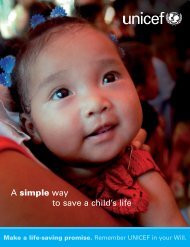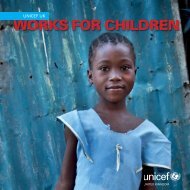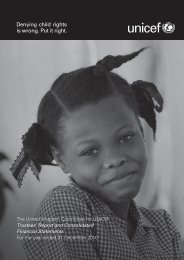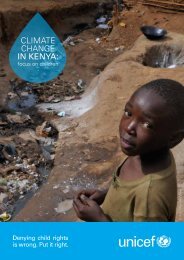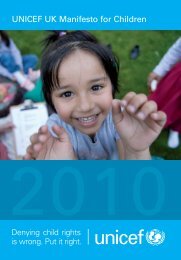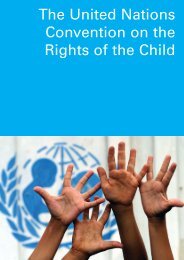The children left behind - Innocenti Research Centre
The children left behind - Innocenti Research Centre
The children left behind - Innocenti Research Centre
You also want an ePaper? Increase the reach of your titles
YUMPU automatically turns print PDFs into web optimized ePapers that Google loves.
2 4 I n n o c e n t i R e p o r t C a r d 9<br />
Box 3 <strong>The</strong> just society: a measure<br />
<strong>The</strong> statistics presented in this Report Card can also<br />
be read as a first attempt to measure nations by the<br />
standards of a ‘just society’ as defined by the American<br />
political philosopher John Rawls (1921 – 2002).<br />
Rawls proposed that the just society would be one in<br />
which the rules were drawn up for the benefit of society<br />
as a whole. To achieve this, he argued, the starting point<br />
should be ‘the original position’. By this he meant a kind<br />
of celestial ante-room in which all those waiting to be<br />
born would draw up the rules without knowing what<br />
position in society they themselves would occupy.<br />
From <strong>behind</strong> this ‘veil of ignorance’, the rule-makers<br />
would not know whether they would be born rich or<br />
poor, male or female, with above or below average<br />
talents, fit or disabled, part of an ethnic minority or part<br />
of a privileged elite.<br />
Because we would not know about our own status,<br />
he argued, we would not be able to press for rules that<br />
would benefit only ourselves. Rules drawn up on this<br />
basis, therefore, would reflect an equal concern for all<br />
classes and groups.<br />
<strong>The</strong> ‘veil of ignorance’ is therefore designed to tame<br />
the power of vested interests. And ‘the original position’<br />
is the exact opposite of the interest group model that is<br />
so influential in today’s politics. In essence, it is similar<br />
to the method of sharing a cake fairly between two<br />
people by inviting one person to make the cut and the<br />
other to take first choice.<br />
Rawls has his critics among the hundreds who have<br />
written books in response to his ideas. Libertarians<br />
have objected that basic human rights such as property<br />
rights and the right to self-ownership leave no room for<br />
a Rawlsian concept of the ‘just society’. Ronald Dworkin<br />
has argued that hypothetical agreements about rules<br />
drawn up from ‘the original position’ are not real<br />
agreements and therefore could not find the necessary<br />
acceptance and authority. Amartya Sen finds the same<br />
weakness, adding that unanimity would be unlikely to<br />
be achieved even from ‘the original position’ and that<br />
lack of unanimity would bring the Rawlsian thesis<br />
crashing down. Uniting some of these criticisms,<br />
Michael Sandel has objected that decisions about the<br />
rules governing communities that have their own<br />
traditions and histories cannot be made by reasoning<br />
from a rootless and historically abstract position.<br />
But the idea that the rules of society should reflect<br />
the interests of all, and not just its dominant members,<br />
is widely accepted in theory, even if the methods by<br />
which it might be achieved remain controversial.<br />
If we assume that the end, if not the means,<br />
commands a measure of agreement, then one way of<br />
measuring progress towards the aim of a just society<br />
would be to measure the degree of disadvantage<br />
suffered by its most disadvantaged members. That is<br />
what this Report Card attempts to do.<br />
Clearly, more comprehensive data would be required<br />
to measure degrees of disadvantage ‘in the round’,<br />
especially if, as Amartya Sen suggests, disadvantage<br />
should be defined as “those who are least able to<br />
realise their potential and develop and exercise their<br />
capabilities.”<br />
Nonetheless, the data presented in these pages<br />
represent a contribution to that process. In three<br />
different dimensions of well-being – material goods,<br />
educational level, and health – they show how far<br />
<strong>behind</strong> the median level the least advantaged are<br />
being allowed to fall. And the fact that different<br />
countries show very different patterns indicates that<br />
some countries are making more progress than others<br />
towards ‘the just society’.


